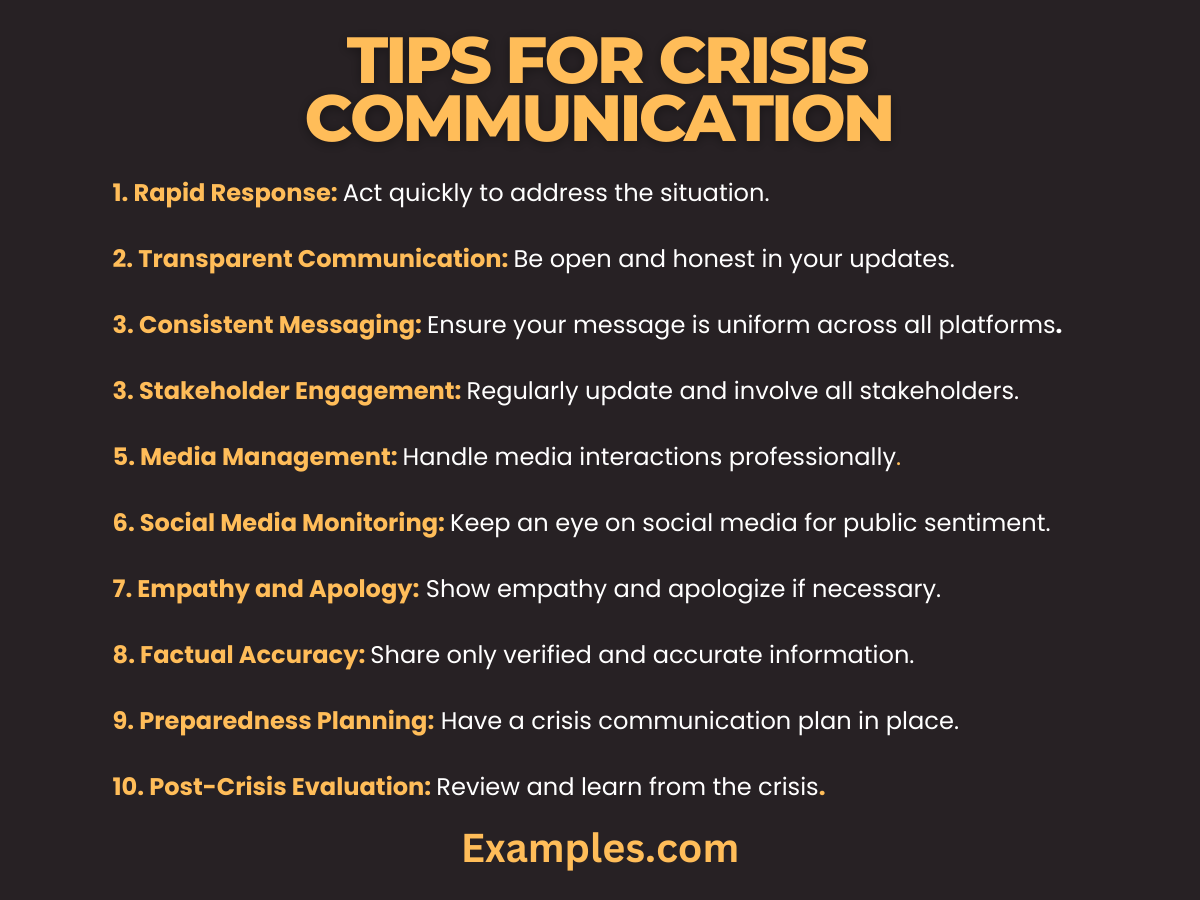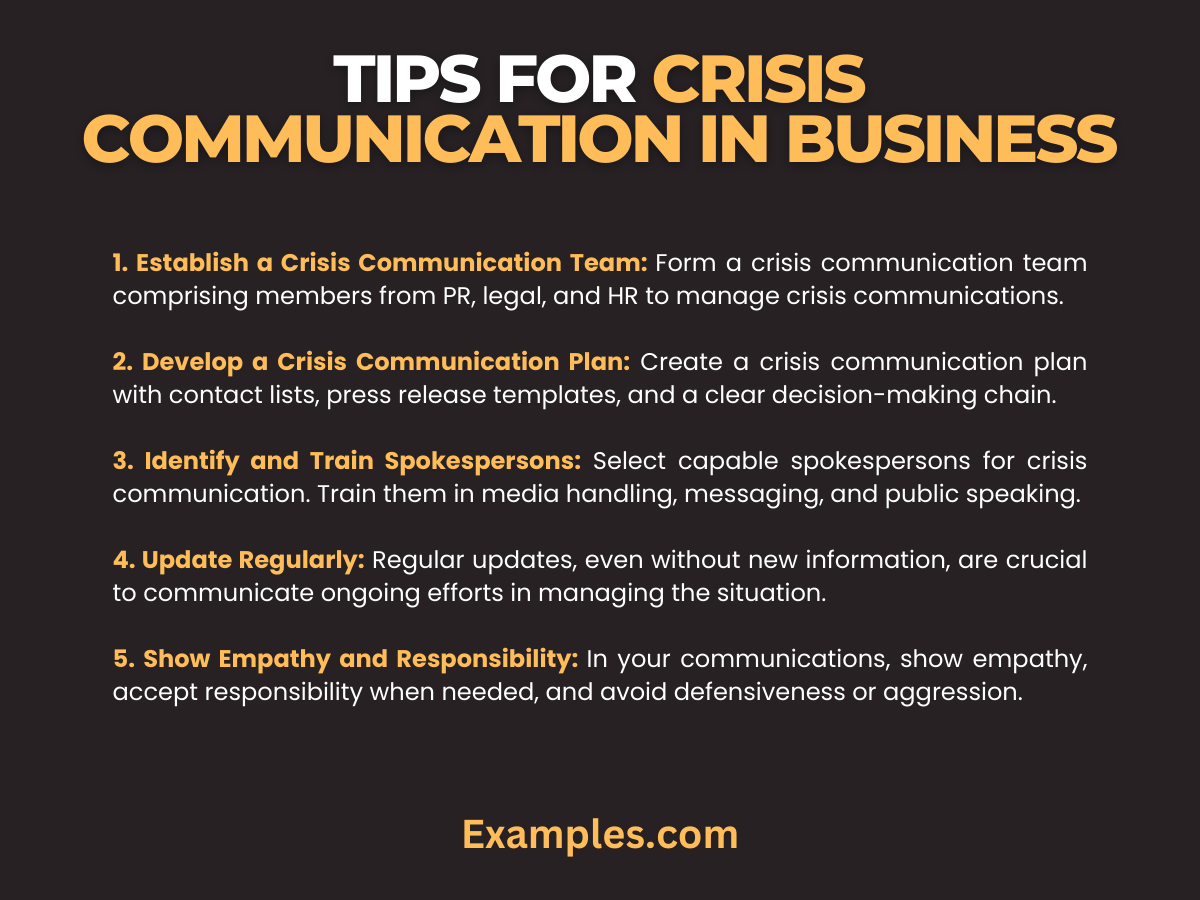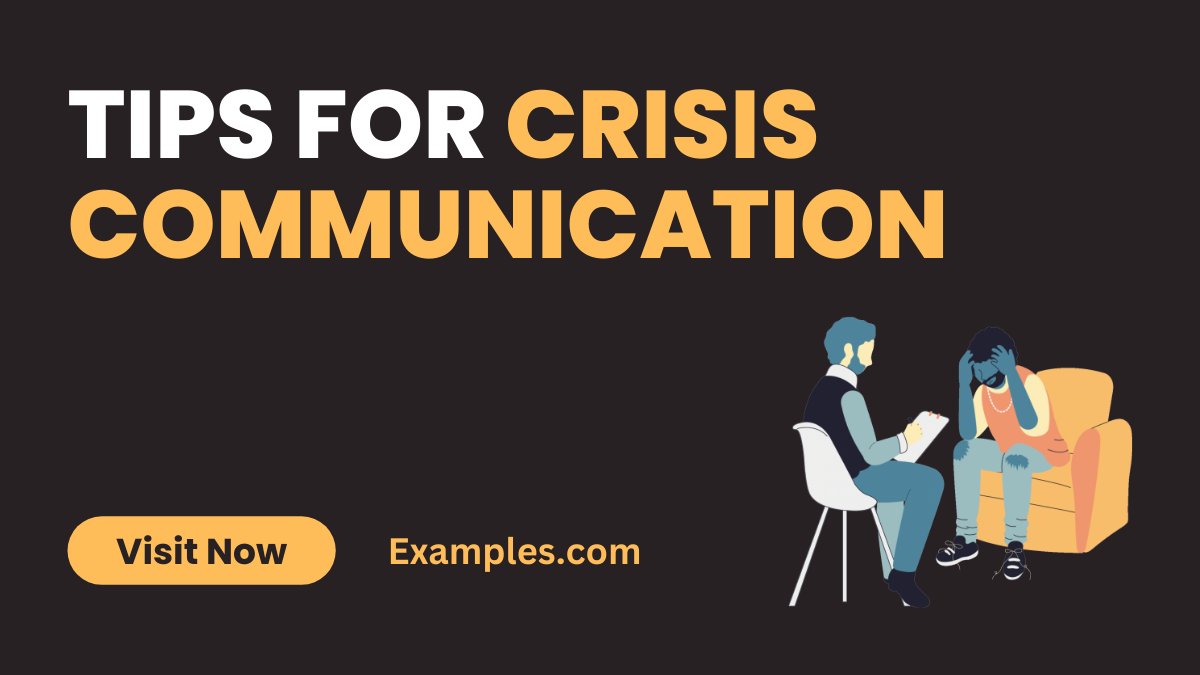29+ Tips for Crisis Communication Examples
In today’s fast-paced and often unpredictable environment, mastering the art of crisis communication is essential for organizations and individuals alike. This comprehensive guide delves into the core principles and strategies for effective crisis communication. It covers a broad spectrum of topics, from rapid response and transparency to empathy and factual accuracy. Whether you’re managing a small team or a large corporation, these actionable tips for crisis communication will equip you with the necessary tools and insights to navigate through challenging times effectively. Discover how to maintain stakeholder trust, manage media relations, and leverage social media monitoring to your advantage, ensuring your message is clear, consistent, and resonates with your audience.
30 Tips for Crisis Communication

Crisis communication is a critical aspect of managing unexpected events and maintaining organizational integrity. Effective crisis communication can mitigate damage, maintain trust, and guide stakeholders through challenging times. Here are 30 unique and essential tips for navigating crisis communication, each accompanied by practical examples.
- Rapid Response: Act quickly to address the situation.
Example: “We are aware of the situation and are actively working to resolve it.” - Transparent Communication: Be open and honest in your updates.
Example: “We want to be transparent about the challenges we are facing.” - Consistent Messaging: Ensure your message is uniform across all platforms.
Example: “Our commitment remains unchanged across all our communication channels.” - Stakeholder Engagement: Regularly update and involve all stakeholders.
Example: “We value your input and will keep you informed at every step.” - Media Management: Handle media interactions professionally.
Example: “We are coordinating with the media to provide accurate information.” - Social Media Monitoring: Keep an eye on social media for public sentiment.
Example: “We are monitoring social media and appreciate your feedback.”

- Empathy and Apology: Show empathy and apologize if necessary.
Example: “We understand the impact and sincerely apologize for any inconvenience.” - Factual Accuracy: Share only verified and accurate information.
Example: “We assure you that the information provided is based on verified facts.” - Preparedness Planning: Have a crisis communication plan in place.
Example: “Our crisis plan has been activated to address this effectively.” - Post-Crisis Evaluation: Review and learn from the crisis.
Example: “We are evaluating our response to improve future strategies.” - Proactive Communication: Anticipate issues and communicate early.
Example: “We are taking proactive steps to prevent potential issues.” - Reactive Communication: Respond effectively to unexpected events.
Example: “We are reacting swiftly to address the current situation.” - Instructional Communication: Provide clear instructions during a crisis.
Example: “Please follow these steps for your safety and well-being.” - Adjustment Communication: Be flexible and adapt messages as needed.
Example: “We are adjusting our approach based on the latest developments.” - Reputation Management: Protect and rebuild your organization’s reputation.
Example: “We are committed to restoring trust and confidence in our brand.” - Internal Communication: Keep employees informed and engaged.
Example: “Our team is our priority, and we’re keeping everyone informed.” - External Communication: Address clients, customers, and the public effectively.
Example: “We are reaching out to our clients with updates and assurances.” - Social Media Communication: Use social media strategically.
Example: “We are actively communicating updates through our social media channels.” - Stakeholder-Specific Communication: Tailor messages to different groups.
Example: “We are addressing the specific concerns of each stakeholder group.” - Post-Crisis Communication: Continue communicating after the crisis.
Example: “Even post-crisis, we will continue to provide updates.” - Situational Awareness: Stay aware of the evolving situation.
Example: “We are constantly monitoring the situation for any changes.” - Cultural Sensitivity: Be mindful of cultural differences in communication.
Example: “We respect cultural differences and are communicating accordingly.” - Legal Considerations: Be aware of legal implications in your communication.
Example: “Our communications are in line with legal requirements.” - Collaborative Approach: Work with partners and experts.
Example: “We are collaborating with experts to manage this crisis effectively.” - Continuous Learning: Learn from each crisis to improve.
Example: “We are committed to learning from this experience.” - Resource Allocation: Ensure resources are available for crisis communication.
Example: “We have allocated necessary resources to manage this crisis.” - Empowerment of Teams: Empower teams to communicate effectively.
Example: “Our teams are empowered to provide timely and accurate information.” - Feedback Loop: Encourage and incorporate feedback.
Example: “Your feedback is crucial for us to improve our communication.” - Technological Integration: Utilize technology for efficient communication.
Example: “We are using advanced technology to streamline our communication.”

- Crisis Simulation Training: Conduct training to prepare for potential crises.
Example: “We regularly conduct crisis simulation exercises for preparedness.”
Tips for Crisis Communication in Business

- Establish a Crisis Communication Team: Create a dedicated team responsible for managing communications during a crisis. This team should include members from different departments such as public relations, legal, and human resources.
- Develop a Crisis Communication Plan: Prepare a comprehensive plan outlining the procedures for communicating during a crisis. This plan should include contact lists, templates for press releases, and a chain of command for decision-making.
- Identify and Train Spokespersons: Choose competent individuals who can effectively communicate on behalf of the organization during a crisis. Train these spokespersons in media handling, crisis messaging, and public speaking.
- Monitor Media and Social Channels: Keep a close watch on what is being said about your organization in the media and on social platforms. This helps in understanding public perception and responding appropriately.
- Communicate Proactively and Transparently: Provide timely and honest information to stakeholders. Transparency helps in maintaining trust and minimizing rumors or misinformation.
- Show Empathy and Responsibility: In your communications, demonstrate empathy towards those affected by the crisis. Accept responsibility where applicable, and avoid defensive or aggressive tones.
- Update Regularly: Regular updates are crucial. Even if there is no new information, communicate the ongoing efforts to manage the situation.
- Post-Crisis Analysis and Feedback: After the crisis, review the effectiveness of the communication efforts. Gather feedback and adjust the crisis communication plan for future incidents.
Mastering crisis communication in business is vital for maintaining trust and reputation. This article has provided valuable tips to navigate turbulent times effectively. By prioritizing transparency, empathy, and clear messaging, businesses can mitigate damage and emerge stronger from crises. The ability to communicate confidently and compassionately in challenging situations is a valuable asset that can safeguard and enhance an organization’s standing in the long run.



